By Steve Temple
Engine Builder Magazine
Sometimes the best opportunities are cleverly hidden in plain view. As one example, when Chris Lafferty of Lafferty Engine Creations was asked why he opted to expand beyond race engines into the hot rod and muscle car arenas, he said, “Just look outside.” His North Carolina facility sits squarely in the middle of both NASCAR and cruisin’ country. But it usually takes more than peering out your shop window to figure out what new markets offer strong potential for your business. And, once you’ve had that epiphany, there’s still serious work to be done to turn a profit.
To lift the heads off the muscle car and hot rod engine business, we talked to nine successful engine builders, who all revealed some good tactics that keep their mills running smooth. Now, here’s the bad news.
We got nine different formulas, directions and approaches to that success. Sorry guys, there’s no silver bullet – no course in Street Performance 101 that will guide you through the pitfalls straight to the top of the class.
Even so, the one element, and probably the most important, that doesn’t seem to vary is the engine buyer. Just who is shelling out the money for a high-performance motor to drop into a ’67 Camaro or ’32 roadster? This should come as no great surprise: The guy behind the wheel of that tricked-out classic is a baby boomer.
The kids are out of school and the house, the pressure of building a career has passed and now it’s time to enjoy the fruits of a lifetime of labor. The boomers are going back to that car they wanted as a kid, but couldn’t afford, or maybe even owned, but didn’t fully appreciate. They remember the high school quarterback who had a blazing orange Camaro convertible. Now, it’s payback time, time to relive those years, but just better and faster.
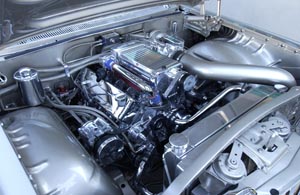 Our boomer buyers won’t be taking their street rods to the track, at least not on a regular basis. That Camaro or Nova will sit in the garage and be caressed with high-quality carnauba wax, waiting for a sunny weekend to cruise the modern version of the traditional drive-in. He wants to be sure that he can squeal his tires if the occasion presents itself, but this is the ride that he not only loves, but also deeply respects the next morning. Just listening to its guttural rumble at the stoplight is enough of a turn-on. Our boomer will visit redline, but that’s not where he wants to live.
Our boomer buyers won’t be taking their street rods to the track, at least not on a regular basis. That Camaro or Nova will sit in the garage and be caressed with high-quality carnauba wax, waiting for a sunny weekend to cruise the modern version of the traditional drive-in. He wants to be sure that he can squeal his tires if the occasion presents itself, but this is the ride that he not only loves, but also deeply respects the next morning. Just listening to its guttural rumble at the stoplight is enough of a turn-on. Our boomer will visit redline, but that’s not where he wants to live.
Our guy may have worn tie-dye in his youth, but he’s meticulous about that car. He’s had a good 40 years to think about his ride and is not about to settle for anything less than his ideal. And perfection is what he’ll look for in his engine builder.
If your brain has started to wrap itself around this demographic character, then you’ll realize it’s not a finite market. Boomers may not have acknowledged it yet, but they are mortal – or at least a decade or two away from having their grandkids take away their car keys. Don’t sweat it. The baby boomers are a massive and broad-end user, ranging in age from 40 to 60 and firmly committed to not being the rocking-chair senior citizens their parents were. Worst-case scenario, your business plan starts to stutter in about 20 years.
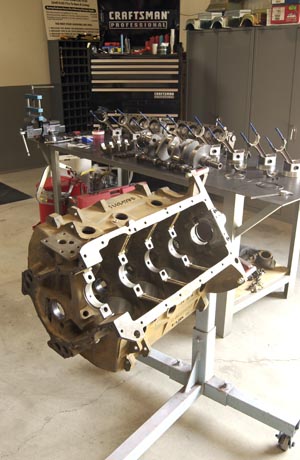 So, that’s your buyer – now what do you call the car he’s obsessing over? The hot rod has long-since passed the traditional, 48th Street milestone for many boomers and builders. There are still purists who make the strong distinction between the authentic pre-’48 hot rod and the muscle cars of the mid-60s and beyond. But the lines are blurred, especially if you look at the origin of the hot rod – the beater passed on from parents to their teenagers, who then souped them up and played chicken against the backdrop of the Griffith Observatory. OK, OK, maybe we’ve watched Rebel Without a Cause once too often. While there are two classes of vehicles, more and more builders and buyers refer to muscle cars as today’s street rods. (And that definition is expanding to include certain other types of sedans, wagons and even trucks, too.)
So, that’s your buyer – now what do you call the car he’s obsessing over? The hot rod has long-since passed the traditional, 48th Street milestone for many boomers and builders. There are still purists who make the strong distinction between the authentic pre-’48 hot rod and the muscle cars of the mid-60s and beyond. But the lines are blurred, especially if you look at the origin of the hot rod – the beater passed on from parents to their teenagers, who then souped them up and played chicken against the backdrop of the Griffith Observatory. OK, OK, maybe we’ve watched Rebel Without a Cause once too often. While there are two classes of vehicles, more and more builders and buyers refer to muscle cars as today’s street rods. (And that definition is expanding to include certain other types of sedans, wagons and even trucks, too.)
Now we have to deal with the different approaches to the business. Many of our builders have racing backgrounds; some are boomers themselves whose lives have paralleled the cars they’re working on; a couple weren’t even born when the first muscle cars roared off the assembly line; some build up to 80 to 100 engines a month, some do that number in a year.
While our builders are primarily coastal, the actual location, thanks to today’s Internet access, may not make much difference. None offers a surefire formula for business success, but all have developed strategies – everything from just plain hard work to using the Internet – that have worked for them. One common denominator is that they all have a passion for what they do. Another, they all either found or were born with a way to set themselves apart from the competition.
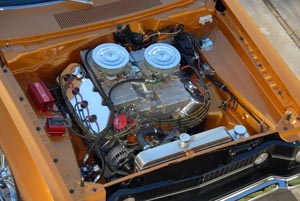 One key way is racing. Logic says that if you can go fast, then you should be able to make me go fast. That’s not exactly the way Jim VanGordon (VanGordon Racing, Upland, CA) explains it. “When you get older and grayer, I guess people think you know what you’re doing.”
One key way is racing. Logic says that if you can go fast, then you should be able to make me go fast. That’s not exactly the way Jim VanGordon (VanGordon Racing, Upland, CA) explains it. “When you get older and grayer, I guess people think you know what you’re doing.”
This highlights that “born with” component. VanGordon is just plain cool, and old guys rule. There’s some truth to his view of longevity though, but in VanGordon’s case, success has more to do with the fact he’s raced nearly everything and won as well, not to mention the fact that he’s damn good.
Example: Norm Kraus (of the legendary “Mr. Norm’s Sport Club” and Grand Spaulding Dodge) and Al Kahmi of Blue Moon Motorsports tapped VanGordon to provide the engines for the GSS Hemi Dart with over 725 horsepower. The lessons to be learned from VanGordon are simple: be very, very good at what you do and how you handle people.
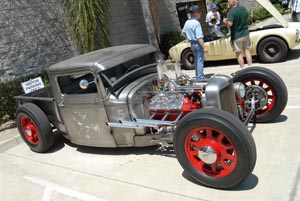 “In the collector car business,” he said, “it’s all word-of-mouth. You can’t burn any bridges.” VanGordon doesn’t advertise, doesn’t rely on his website, people just walk in the door. “Guys will come in with a $4,000 budget, a pile of parts in the back of his pick-up and want the most horsepower he can get. There are small things you can do to an old engine to get more out of it. We know how to do that.”
“In the collector car business,” he said, “it’s all word-of-mouth. You can’t burn any bridges.” VanGordon doesn’t advertise, doesn’t rely on his website, people just walk in the door. “Guys will come in with a $4,000 budget, a pile of parts in the back of his pick-up and want the most horsepower he can get. There are small things you can do to an old engine to get more out of it. We know how to do that.”
With 35 years experience, he can make a Chevy smallblock sing. When a ’67 Chevelle rolls in with a driver awed by the racing technology behind the new Vipers or Shelby Cobra and wants his Bowtie block to run at 8,000 rpms, Van Gordon knows how to do that as well – as long as the driver has the money.
Another racer/engine builder who follows VanGordon’s less-is-more, non-marketing strategy is Tom Hemphill (Hemphill Racing Engines, Clarksburg, PA). He started racing at 18 and the business grew out of his success on the track. Some 23 years later, more than half his workload is still racing engines. While his street engine customers come to him because of his background,
“What they really want is an older engine that performs well on pump gas,” Hempill said. “They’re looking for low maintenance, but want to squeal the tires when they hit the gas."
Hemphill doesn’t see muscle car and hot rod engine building as a growing business, but of course not everybody agrees.
On the other side of the age and enthusiasm dividing line sits 29-year-old Chris Lafferty of Lafferty Engine Creations. With the ambitious goal of being the Walmart of engines, he grew up in Southern California with drag and street racing. He later moved to North Carolina to get into racing engines, slept in his rental truck until he could find a place to live and built NASCAR Busch Grand National engines out of his garage. Now, he’s got a plan.
“The first thing is reputation,” he said. “At 22, I was the youngest NASCAR engine builder.” And he’s done well in the Clevite Engine Builder Showdown.
The next step on Lafferty’s ladder is exposure. He started writing for Circle Track to help establish credibility. He got into racing in the NASCAR Craftsman Truck Series to get exposure for both himself and his R&D customers. The next step is a semi-reality show on MavTV.
“The series will follow the growth of the Craftsman team,” he commented, “showing how somebody can really live the dream.” But, Lafferty knows exposure and reputation won’t pay the bills. “You have to have the same integrity and the same care with street engines that you do with racing engines,” he said. “I ask the customer what he wants, what he needs. If they can’t afford a whole engine rebuild, I’ll help him discover what I CAN do for him.”
While racing helps at the outset, being in the right place at the right time with the expertise is the element that started Bruce Nelson (The Engine Factory, Lebanon, NJ) in the business nearly 40 years ago, where he was working on GTOs at a Pontiac dealer in ’64.
“When the government screwed everything up and nearly killed the industry, I went out on my own.” Now he and his sons build 80 engines a month for an international market. While he concentrates on Ford and Chevy small-block engines from the ‘60s, his business is generated with 21st century technology – the Internet.
“We get 90 to 99 percent of our business off the Internet,” he says. “We own 120 domain names, so if you surf the web for an engine, you’ll get us.”
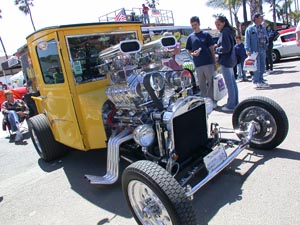 With the kind of investment Nelson has in the family business, he sees the muscle car and hot rod business booming indefinitely for a couple of reasons: “The big thing now is resto-modifications. The frame and bodywork are original, but everything else is high tech. The technology we’re working with now will last 40 to 50 years.” Also driving that nostalgic trend is the lack of character in newer vehicles. “Ninety percent of the new cars now have good technology, but they’re plastic, no style, nothing distinctive.”
With the kind of investment Nelson has in the family business, he sees the muscle car and hot rod business booming indefinitely for a couple of reasons: “The big thing now is resto-modifications. The frame and bodywork are original, but everything else is high tech. The technology we’re working with now will last 40 to 50 years.” Also driving that nostalgic trend is the lack of character in newer vehicles. “Ninety percent of the new cars now have good technology, but they’re plastic, no style, nothing distinctive.”
For the guy who wants to keep the investment value of his classic, the original engine is crated and stored, replaced with a newer version. “Then if he sells it, the new owner has the original matching numbers.”
Like the Engine Factory, Frank Beck (Beck Racing Engines, Phoenix, AZ) offers his street rod customers a broad range of engine packages. “Our job is to help the customer determine which package he needs.” Even then, there’s a lot of custom work and detail to end up with a satisfied end user.
“This is a passion-driven business,” Beck said. “You have to love what you do and figure out a way to make a living doing it. You have to have a way to set yourself apart from the crowd. We were all young and dumb when we started. If we’d looked at the capital investment versus return, nobody in their right mind would do this.”
Beck actively markets the business through print ads in car-enthusiast magazines, but says his most valuable marketing tool is exposure on Google. His primary target is the high-end performance guy who’s done his homework. “I ask myself what I’d like to see if I were to spend $10,000 to as much as $50,000 on an engine. I’d want to see a professional operation – and that’s what we’ve built here.”
Equipment is a big deal for a lot of the builders we talked to. “You have to be self-sufficient,” said Byron Raney (Raney Race Engines, San Paulo, CA). “You have to have the guts to make the investment.”
Raney bought one piece of equipment at a time and now, 20 some years later, he’s state-of-the-art. Besides the tools, Raney says you have to work long hours and have contacts. “It’s hard to break into this business unless you’ve got some grassroots experience,” he admitted. “My advantage was working with some of the top fuel teams when I was 18 to 23 years old. You have to be willing to do what you have to in order to make money in this business.”
While customer names like Don Prudhomme and Shirley Muldowney give Raney street cred, one of his best marketing tools is his ’64 Nova with 18-inch tires. “I drive it on weekends,” he said. “It sounds like a funny car and really turns heads.”
Ironically, the biggest competition for builders is not other builders – it’s a GM crate engine you can grab up for $1,800, as well as the mail-order businesses with cheap parts. “You have to give your customer a reason to come to a shop for a custom engine,” Raney pointed out. His reasons are his workmanship, attention to detail and taking care of any problems that may come up.
Because of the competition of mail-order companies, Jay Steel (Taylor Engines, Whittier, CA) concentrates on authentic hot rods. “Eighty percent of what we do are antiques,” he said. “The other 20 is job shop work.” For Steel, the real hot rods are one way for a small shop to have some success. “Guys can’t go shopping for a flathead,” he noted. Over the 37 years he’s owned Taylor, Steel has seen his share of ups and downs and he was able to flow with the market and survive serious slumps. When the Northridge earthquake shook “closed” signs onto the doors of other shop owners whose buildings had been condemned, Steel could hang in until business picked up. “This is really a toy market and it’s tied to the economy. People don’t have to have hot rods or muscle cars.”
Rich Maitre (Oxford, PA) has found another avenue into the hot rod/muscle car engine business. He’s the guy engine builders without their own equipment farm out work to. His niche: cylinder heads and manifolds.
“There are only a handful of people who do what I do,” Maitre said. “I’m a big fish in a little pond.” He started working for other shops more than 20 years ago. When his last employer closed up his shop, he inherited the client list, but nothing else. In 2000, he had a hand grinder and that list; all the money he made went into equipment. He’d work from 9 a.m. to midnight some days and now life is good. “The nature of my work is all the upper end of performance. Almost all the work I do is for muscle car or hot rod engines that will end up in some form of racing.”
As for other market segments, “The younger drivers are taking the tuner thing and making those kinds of performance demands on hot rod and muscle car chassis,” Maitre said. “They don’t care about holding an idle or any of the comfort features. They’ll sacrifice that for the performance.”
This “younger” post-boomer, probably children or grandchildren of boomers, is a bit of a mystery to some builders. (Ah, do we spy an opportunity?) Beck sees them as go-fast drivers who aren’t willing to work on the engines – non-gearheads. Raney admits the popularity of imports makes it hard to attract younger customers. “Some kids will go up against anything with a big V8, but it’s hard to compete against imports on nitrous,” he explained.
Kolby Enger (Turn Key Engine Supply, Oceanside, CA) isn’t fazed by this mystery. Maybe because, like Lafferty, at 31, he is of that generation. Enger started the business about five years ago, building high-performance engines for off-road competition and sand rails. Two years ago, he expanded into street applications and now between 35 and 40 percent of the roughly 700 engines he builds a year fit that description. While the more popular cars Turn Key engines end up in are ’55 to ‘57 Chevys and ’67 to ‘69 Camaros, the engines are LS1 and LS2s.
“My customers have driven new Corvettes and there’s a night and day difference. Why go backwards?” Enger said.
One step beyond the resto-mods lies another made-up word – restification. Like the Mr. Norm GSS Hemi Dart, classics are physically restored but internally gutted. Old technology is replaced with fuel injection, EFI, and high-tech suspensions and brakes. That’s Enger’s market. His desert racing engines helped street customers recognize that his engines would stand up to hard conditions, but he incorporated traditional advertising and public relations into his expansion plan as well. His contacts with a Kenne Bell supercharged project on a ’57 Sedan Delivery called “Winged Express” landed him some enviable ink.
This is the point where we’d like to draw some conclusions, but we won’t. You can’t rewind your life and stick in a few trips to the winner’s circle. You and your business are where they are. But if you listen to muscle car and hot rod performance engine builders, you can find a lot of good information that should work for you. If you don’t have a racing background, you need to figure out something else to set yourself apart. If people don’t walk in your shop with pockets of cash, you may want to look at the Internet or good PR opportunities. But, if this is your passion and you work your butt off, we just may end up calling you in a couple of years to ask about the key to your success.
